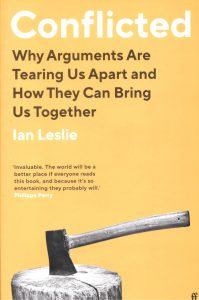The one sentence summary
Although arguments appear to be tearing us apart, conflict can bring us together if approached in the right way.
Can’t be bothered to read it? Too much screen time lately? Listen to the 5-minute podcast in two parts.
WHAT THE BOOK SAYS 
- Disagreement is beneficial because it exposes problems and instigates change. A medium level of conflict leads to a high degree of success.
- Couples and teams are happier when they are in the habit of passionate disagreement. Conflict can bring people together.
- The occasional row leads people to update their mental models and it flushes out new information for all parties. The alternative is not airing our differences, and research shows that there are no benefits of passive aggression or low-level sniping.
- Appointing a devil’s advocate reduces groupthink and prevents teams from arriving at a consensus prematurely – it encourages diversity. A lot of confirmation bias is bad, but so is none of it, leading to lifeless discussions in which the dominant view isn’t tested.
- The author’s rules for productive argument are:
- First, connect: Before getting to the content of the disagreement, establish a relationship of trust.
- Let go of the rope: To disagree well, you have to give up on trying to control what the other person thinks or feels.
- Give face: Disagreements become toxic when they become status battles. The skilful disagreer makes every effort to make their adversary feel good about themselves.
- Check your weirdness: Behind many disagreements is a clash of cultures that seems strange to each other. Don’t assume that you are the normal one.
- Get curious: The rush to judgement stops us listening and learning. Instead of trying to win the argument, try and be interested – and interesting.
- Make wrong strong: Mistakes can be positive if you apologize rapidly and authentically. They enable you to show humility, which can strengthen the relationship and ease the conversation.
- Disrupt the script: Hostile arguments get locked into simple and predictable patterns. To make the disagreement more productive, introduce novelty and variation. Be surprising.
- Share constraints: Disagreement benefits from a set of agreed norms and boundaries that support self-expression. Rules create freedom.
- Only get mad on purpose: No amount of theorising can fully prepare for the emotional experience of a disagreement. Sometimes your worst adversary is yourself.
- Golden rule: Be real: All rules are subordinate to the golden rule: make an honest human connection.
WHAT’S GOOD ABOUT IT
- Calibrate your communication style to the other person’s emotional temperature: start where they’re at.
- The righting reflex is the desire to put the other person right – it lies behind many dysfunctional disagreements.
- An argument can be defined as an emergency of self-definition.
- Identity-protective cognition means that we perceive what supports our identity and ignore what does not.
- Hedging helps constructive arguments, including phrases such as ‘it could be the case’.
- Weakness is power because it makes the other person let their guard down. By contrast, cleverness is stupidity.
- The word politeness comes from polishing – when discussing things, we ‘polish’ the other person’s views.
- Overall, don’t impose, give options, and make your interlocutor feel good. Stop trying to be right, resist negative reciprocation, don’t tell them what to do or feel, and create rather than correct.
- The best disagreements neither reinforce nor eradicate a difference but make something new out of it.
WHAT YOU HAVE TO WATCH
- Nothing. This is a thought-provoking and helpful book.
